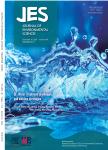Constructing a Raman and surface-enhanced Raman scattering spectral reference library for fine-particle analysis
Constructing a Raman and surface-enhanced Raman scattering spectral reference library for fine-particle analysis作者机构:Key Laboratory of Resources and Environmental System Optimization of Ministry of EducationCollege of Environmental Science and EngineeringNorth China Electric Power UniversityBeijing 102206China State Key Joint Laboratory of Environment Simulation and Pollution ControlSchool of EnvironmentTsinghua UniversityBeijing 100084China State Key Laboratory of Environmental Chemistry and EcotoxicologyResearch Center for Eco-Environmental SciencesChinese Academy of SciencesBeijing 100085China Guangdong Provincial Key Laboratory of Petrochemcial Pollution Processes and ControlSchool of Environmental Science and EngineeringGuangdong University of Petrochemical TechnologyMaoming 525000 China
出 版 物:《Journal of Environmental Sciences》 (环境科学学报(英文版))
年 卷 期:2022年第34卷第8期
页 面:1-13页
核心收录:
学科分类:07[理学] 070602[理学-大气物理学与大气环境] 0706[理学-大气科学]
基 金:supported by National Natural Science Foundation of China (Nos. 21707077, 21775042, and 21475134) the National Key Research and Development Program of China (No. 2017YFA0207003) the Special Fund of Beijing Key Laboratory of Indoor Air Quality Evaluation and Control (No. BZ0344KF2006) the Fundamental Research Funds for the Central Universities (No. 2020MS037)
主 题:Raman Surface-enhanced Raman scattering(SERS) Spectral library Fine-particle
摘 要:Fine particles associated with haze pollution threaten the health of over 400 million people in China. Owing to excellent non-destructive fingerprint recognition characteristics, Raman and surface-enhanced Raman scattering(SERS) are often used to analyze the composition of fine particles to determine their physical and chemical properties as well as reaction mechanisms. However, there is no comprehensive Raman spectral library of fine particles. Furthermore, various studies that used SERS for fine-particle composition analysis showed that the uniqueness of the SERS substrates and different excitation wavelengths can produce a different spectrum for the same fine-particle component. To overcome this limitation, we conducted SERS experiments with a portable Raman spectrometer using two common SERS substrates(silver(Ag) foil and gold nanoparticles(Au NPs)) and a 785 nm laser. Herein, we introduced three main particle component types(sulfate-nitrate-ammonium(SNA), organic material, and soot) with a total of 39 chemical substances. We scanned the solid Raman, liquid Raman, and SERS spectra of these substances and constructed a fine-particle reference library containing 105 spectra. Spectral results indicated that for soot and SNA, the differences in characteristic peaks mainly originated from the solid-liquid phase transition;Ag foil had little effect on this difference, while the Au NPs caused a significant red shift in the peak positions of polycyclic aromatic hydrocarbons. Moreover, with various characteristic peak positions in the three types of spectra, we could quickly and correctly distinguish substances. We hope that this spectral library will aid in the future identification of fine particles.



